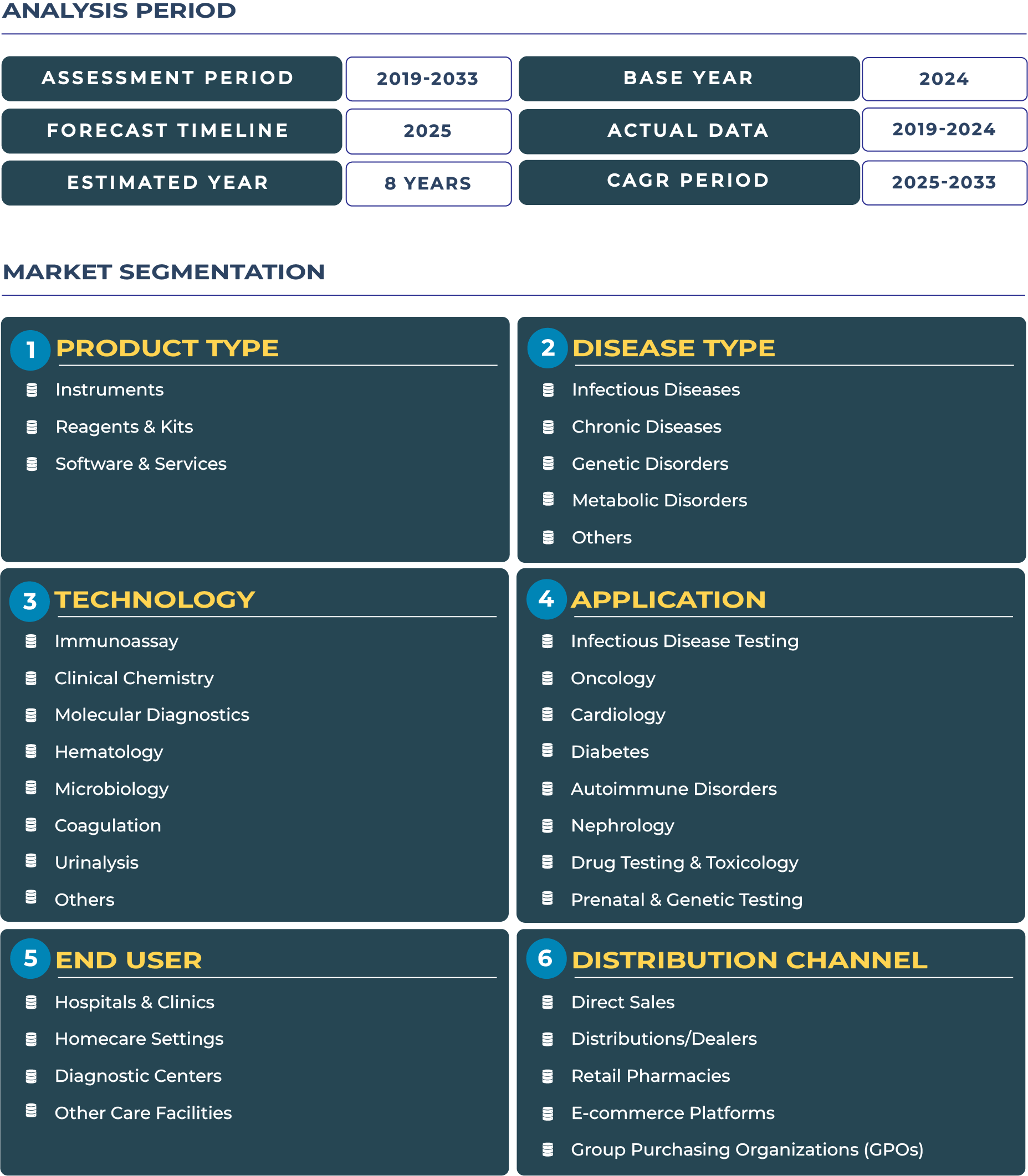Canada In-vitro Diagnostic Market Outlook: A Model of Precision in a Universal Healthcare Ecosystem
The Canada In-vitro Diagnostic (IVD) market stands as a benchmark in how a publicly funded healthcare system can foster clinical innovation, diagnostic accuracy, and sustainable cost containment. Anchored within the Health Canada regulatory framework, the nation’s IVD landscape is influenced by its commitment to equitable healthcare access and its rigorous evaluation of medical technologies. In a country where healthcare delivery is universally accessible, the diagnostic sector plays a pivotal role in early disease detection, chronic care management, and pandemic preparedness.
According to market estimates, the Canada IVD market is projected to grow from USD 3.63 billion in 2025 to USD 5.08 billion by 2033. This growth trajectory reflects the expanding molecular diagnostics portfolio, the rise in point-of-care (POC) testing, and the integration of advanced data analytics in clinical laboratories. Strategic focus on preventive diagnostics and precision medicine continues to strengthen Canada’s leadership in this domain, making it one of the most mature diagnostic ecosystems globally.
Universal Healthcare and Diagnostic Precision Drive Sustainable Market Growth
Canada IVD market is primarily shaped by its universal healthcare framework, where public reimbursement and value-based procurement models determine technology adoption. The integration of molecular testing and immunoassay systems in hospitals and diagnostic centers reflects a growing emphasis on efficiency, cost-effectiveness, and accessibility. In recent years, regional health authorities have accelerated investments in digital diagnostics infrastructure, aligning with the Canadian Institute for Health Information (CIHI) initiatives to improve disease surveillance and laboratory data exchange.
The post-pandemic period has also emphasized the critical role of diagnostics in national health security. With Health Canada tightening standards for clinical validation and post-market surveillance, vendors are focusing on compliant reagent and software solutions to maintain market access. The sustained government commitment to early disease detection, supported by digital health transformation programs, underpins long-term growth in the IVD sector. As precision diagnostics gain prominence, the Canadian IVD market is expected to transition toward more personalized and data-driven care delivery models by 2033.
Drivers and Restraints: Understanding the Forces Behind Market Momentum
Public System Backlog Clearing and Provincial Investments Accelerate Diagnostic Adoption
One of the strongest drivers of the Canadian IVD market is the national effort to clear procedural backlogs caused by the pandemic. Provinces such as Ontario and British Columbia are investing heavily in laboratory capacity enhancement, including reagent supply chain automation and software-supported data management. The rise of genomic testing and companion diagnostics, particularly in oncology and infectious diseases, further stimulates adoption in hospitals and reference laboratories. Additionally, the increasing demand for rapid POC diagnostics in rural and underserved regions reflects the system’s push for equitable healthcare access, amplifying market opportunities for both global and domestic players.
Centralized Procurement Delays and Budget Constraints Temper Expansion Pace
Despite its strengths, Canada’s publicly funded procurement model introduces structural challenges for IVD manufacturers. Centralized purchasing processes at the provincial level often lead to extended tender cycles and slower market entry for new instruments and kits. Moreover, fiscal constraints and fixed annual budgets restrict procurement flexibility, especially for smaller diagnostic facilities. Compared to the U.S., private sector participation remains lower, limiting price elasticity and competitive differentiation. These dynamics collectively moderate growth potential and emphasize the importance of evidence-based procurement strategies for sustained vendor performance in Canada’s IVD landscape.
Trends and Opportunities: The Next Phase of Diagnostic Evolution in Canada
Digital Pathology Integration and Regional Laboratory Hubs Reshape Market Structure
Canada IVD industry is undergoing a transformative phase characterized by the establishment of regional laboratory hubs and the gradual integration of digital pathology and remote diagnostics. Provinces like Quebec and Alberta are experimenting with data-linked IVD networks to streamline testing workflows and accelerate reporting accuracy. The rise in telehealth adoption has also expanded the use of at-home collection kits, backed by public health reimbursement for chronic disease monitoring. Moreover, government incentives for bioinformatics and laboratory automation solutions have encouraged software vendors to align product development with evolving provincial diagnostic priorities.
Private-Public Partnerships and Predictive Diagnostics Open New Growth Frontiers
The future of the Canadian IVD sector lies in the collaboration between public entities and private technology providers. Public-private diagnostic partnerships are emerging in areas such as infectious disease surveillance, oncology screening, and chronic disease analytics. Companies are introducing leasing and subscription-based models for reagents and diagnostic instruments, reducing upfront costs for healthcare providers. Predictive diagnostics leveraging AI-based algorithms (in compliance with Health Canada standards) are anticipated to redefine disease management strategies, driving long-term growth in both reagent and software sub-segments of the market.
Competitive Landscape: Collaborative Innovation Defines Market Leadership
The Canada In-vitro Diagnostic market features a dynamic blend of global leaders and domestic innovators. Major international players such as Roche Diagnostics, Abbott, and Siemens Healthineers operate alongside regional entities providing customized laboratory solutions tailored to the Canadian healthcare model. Recent developments highlight a shift toward collaborative innovation, with leading vendors engaging provincial procurement authorities early in project cycles to ensure compliance and secure multi-year contracts.
For instance, Roche’s expansion of molecular testing platforms across Canadian hospital laboratories in 2024 aligns with the government’s priority of reducing diagnostic turnaround times. Similarly, Abbott’s continued investment in point-of-care testing solutions supports the nationwide demand for decentralized healthcare. Vendors are also focusing on localized reagent production and service networks to mitigate cross-border supply chain vulnerabilities, ensuring resilience amid global economic and geopolitical uncertainties.







